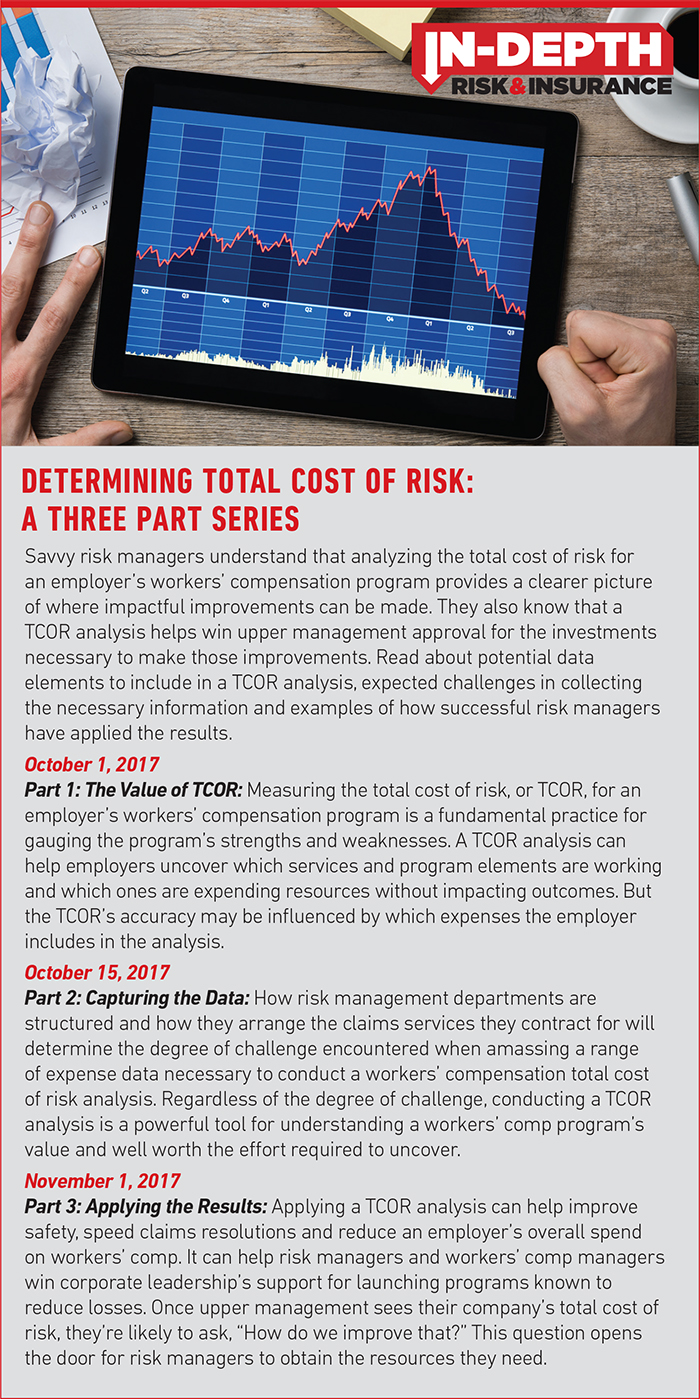In Depth: Workers' Compensation
Calculating Total Cost of Risk in Comp is an Imprecise Science

Determining what to include in a total cost of risk analysis for a workers’ compensation program is an imprecise exercise.
Yet uncovering and measuring the total cost of risk, or TCOR, is a fundamental practice for gauging the strengths and weaknesses of a workers’ comp program’s individual components. It can help determine the efficient allocation of resources so each component is optimally managed to extract the best results from the entire program.
“It’s a precisely measured, nebulous term,” explained Pamela F. Ferrandino, a vice president at Gallagher Bassett.
“While TCOR can be nebulous, it’s important to define it and continue to measure it and see where you can make rational improvements.”
TCOR is an invaluable communications tool, added Carolyn Snow, director of risk management at Humana Inc.
Humana insures its workers’ comp risks through a captive and allocates insurance costs to individual business units. TCOR helps communicate to the upper management of those business units why their losses may be driving any additional expense, said Snow, who was the Risk and Insurance Management Society Inc. president in 2014.
“You are not going to go to a business unit CFO and say ‘You know, your costs are going up.’ They are going to ask why and you are not going to say, ‘They just are,’ ” Snow elaborated.
“You might do that one time, but you will never do it again without having a good business case of why,” she said.
TCOR is often thought of in its simplest form, typically including insurance costs plus claims liability expenses and administration costs. It is commonly mentioned as one entire amount comprised of the sum of those components.
But for a more sophisticated dive into how workers’ comp program spending is paying off, or not paying off, a wider array of components can be included in how TCOR is defined. More precise use also calls for viewing TCOR as a rate that is compared to payroll or some other useful marker — say, for example, $13 per $1,000 of payroll.
Additional components in a TCOR analysis can include brokerage fees, collateral costs, legal services, reserves, risk management staff salaries and benefits along all claims management services such as nurse case management and more.
TCOR can even include the cost of office space for an employer’s workers’ comp department, said Joe Picone, casualty claims practice leader at Willis Towers Watson.
Employers frequently use TCOR to gauge how well their claims administrators are managing various workers’ comp services they contract for, said Paul Braun, managing director for Aon Global Risk Consulting.
In addition to gauging whether a workers’ comp program is functioning optimally or going off kilter, brokers selling TCOR analysis services argue that employers can apply it to help evaluate appropriate risk retention levels and assist in negotiations for better insurance pricing.
It can play a role in determining the best allocation of capital and assist in making risk management personnel decisions, they said.
The rise in use of claims analytics, like predictive modeling, make it increasingly useful to conduct TCOR evaluations to measure whether actionable program changes made at the suggestion of those analytic findings improved outcomes, Braun said.
Otherwise, workers’ comp managers could expend too much effort executing program changes that theoretically should reduce claims costs, but are not producing the desired impact.
“If it isn’t saving you any money, it might require a lot of activity and it might sound good, but it’s not impacting the overall cost of risk,” Braun said.
Applications for TCOR are evolving along with the spread of claims analytics, Ferrandino added.
Gallagher Bassett, for example, developed a system that measures an individual claim’s attributes to gauge its complexity. That information, used in conjunction with TCOR to benchmark a workers’ comp program against peer companies, provides additional insight for determining risk retention levels, she said.
“If you have a higher complexity than your peers, you might want to take a lower retention to mitigate the volatility,” Ferrandino explained.
An aging workforce exacerbating the severity of today’s claims also make understanding an employer’s TCOR increasingly critical, Braun said.
“If you squeeze premiums then losses may go up. If you squeeze losses then broker fees may go up. If you squeeze broker fees then insurance premiums may go up.” — Mark Noonan, managing principal, casualty at Integro
Aging workers may require employers to modify their return-to-work program parameters, for example. That calls for evaluating whether such modifications are paying off.
“It is looking at services that traditionally make sense, but need to be modified,” he said.
Periodically reviewing the TCOR rate is comparable to checking whether an automobile dashboard’s engine warning light is activated, Picone explained. A changing TCOR rate will not describe what is wrong with a workers’ comp program, just as the car’s engine warning light won’t reveal what is wrong with the vehicle.
But like an engine warning light, changes in a TCOR rate trend alerts that something is amiss, requiring further examination.
TCOR rate changes can prompt the risk manager to ask “is it a positive trend or a negative trend?” Picone said. “And if it is negative, why? Then you peel it back and ask ‘Is it claims mapping costs, is it loss costs, collateral costs, vendor costs, etc?’ ”
Picone cited the example of a client whose spend on nurse case management services increased by hundreds of thousands of dollars over a few years.
“Their loss adjustment expenses for claims went through the roof” while their TCOR rate deteriorated, rather than improved.
The increase in expenses and deteriorating TCOR rates pointed to a potential for savings by reducing nurse case management services.
TCOR provides a useful, “whole-picture” look at how changes to one part of a program might impact other parts of the program, agreed Mark Noonan, managing principal, casualty, at broker Integro.
“Being able to look at the total picture provides the opportunity to see where things are working and where they are not and how you act in one area impacts other areas,” Noonan said.
TCOR analysis also benefits companies by providing a more consistent and efficient organizational approach to risk management that can ultimately help company profitability.
“There is certainly a benefit,” he said.
But too much emphasis on shrinking TCOR has risks.
Reducing insurance premiums by changing underwriters, or slashing claims management fees by contracting with a lower-cost claims administrator could quickly reduce TCOR.
But a cheaper insurer or third party administrator may pay less attention to loss-reduction practices, driving up loss costs.
“I have always viewed total cost of risk as similar to the analogy of a Jell-O mold,” Noonan said.
“If you squeeze premiums then losses may go up. If you squeeze losses then broker fees may go up. If you squeeze broker fees then insurance premiums may go up.”
Managing by TCOR requires prudent decision making, Picone agreed.
“You can’t keep squeezing (TCOR) down to the point where you are jeopardizing coverage or jeopardizing outcomes, or service to your employees,” he said.
Depending on corporate culture and financial strength, some employers may provide certain workers’ comp services despite their TCOR impact.
An employer with a reputation for caring for its workers, for example, might provide injured employees with additional nurse case management care beyond an amount shown to be financially optimal.
Despite the advantages of understanding TCOR, employers do not always call it by its formal name nor do they always conduct a workers’ comp program TCOR analysis, Noonan said.
Even in those cases, however, risk managers evaluate the return on investment from their workers’ comp program spend.
But they could still benefit further from TCOR analysis, allowing a more complete view of their program’s efficiency, Noonan said.
But there is one argument for understanding a program’s TCOR that will make sense to risk managers.
Current workers’ comp insurance market conditions leave little room for employers to glean substantial savings there, Ferrandino said.
“But where the opportunity is for clients (to save workers’ comp dollars) is really in managing the risks they have,” she said. “It’s claims management and bringing greater resolution.” &












